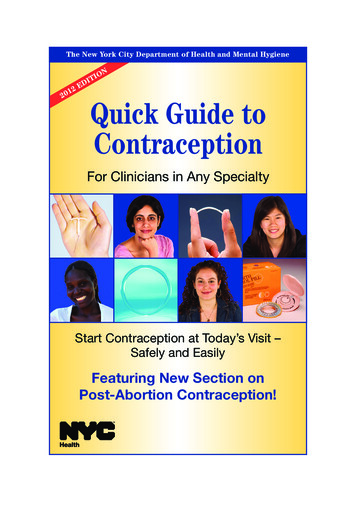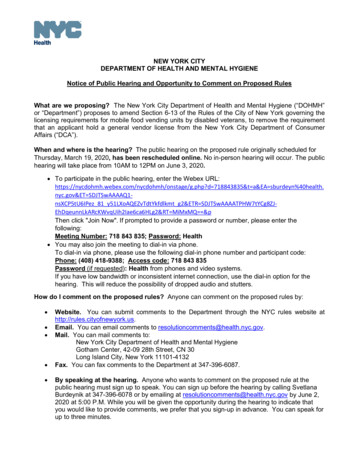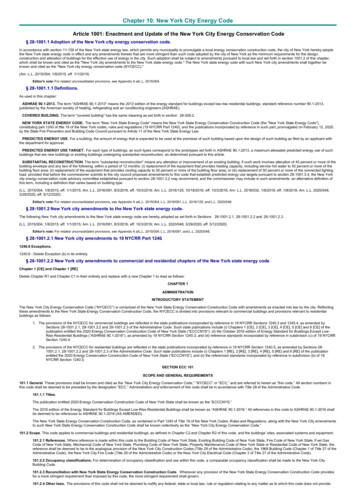
Transcription
Quick Guide to Contraception Bro2012-6 Layout 1 6/20/12 12:47 PM Page 1The New York City Department of Health and Mental Hygiene2012IEDTIONQuick Guide toContraceptionFor Clinicians in Any SpecialtyStart Contraception at Today’s Visit –Safely and EasilyFeaturing New Section onPost-Abortion Contraception!
Quick Guide to Contraception Bro2012-6 Layout 1 6/20/12 12:47 PM Page 2How to Use This Quick GuideContraception is safe and easy to provide.It carries fewer health risks than pregnancy, andnearly all women can use most methods.Helping patients choose an appropriate methodis not complicated. Most women, includingadolescents, need only a focused history, a bloodpressure check and minimal follow-up to begincontraception.Contraception can start today. “Quick Start” isthe preferred, simple way to start contraception attoday’s office visit. Pelvic exams and Pap tests arenot required.This Quick Guide provides simple, state-of-the-artguidelines for busy clinicians in ANY specialty onhow to:1. Routinely assess the reproductive healthneeds of all patients — including adolescents.2. Prescribe appropriate contraception, includingemergency contraception, to all women—including adolescents.3. Provide appropriate contraception immediatelyafter an induced or spontaneous abortion.For more information on contraception, seeInformation and Resources on page 13, call 311or visit nyc.gov/health.First Printing: May 2008Revised/Reprinted: June 2012
Quick Guide to Contraception Bro2012-6 Layout 1 6/20/12 12:47 PM Page 3ContentsOverview2Take a Brief Sexual Health History3Assess Eligibility for Hormonal Contraception4Use Quick Start to Initiate Contraception Today6Oral Contraceptive Pills7Other Combined Hormonal Methods8Other Progestin-Only Methods8Non-Hormonal Methods8Important Prescribing Practices9Help Patients Make the Best Choice10Post-Abortion Contraception11Emergency Contraception:Hormonal Methods and Copper IUD12Information and Resources13AbbreviationsCDC Centers for Disease Control and PreventionCHCs Combined Hormonal Contraceptives (including combined oralcontraceptive pills, patch, ring)COCs Combined Oral ContraceptivesDMPA Depot medroxyprogesterone acetate (Depo-Provera)ECEmergency ContraceptionIUDIntrauterine DeviceLNGLevonorgestrelPOPs Progestin-Only PillsSTI(s) Sexually Transmitted Infection(s)VTEVenous ThromboembolismWHO World Health Organization1
Quick Guide to Contraception Bro2012-6 Layout 1 6/20/12 12:47 PM Page 4Overview1. Routinely discuss contraception with all women ofreproductive age, including adolescents. Take a brief sexual health history. Ask about sexualactivity, HIV status, STIs, and condom and contraceptiveuse. (See page 3.) Explain the importance of contraception and a plannedpregnancy to good health. Dispel myths about the safety of contraceptive methods. Help your patient choose an appropriate method.Consider age, weight, sexual risk behaviors, smokingstatus, general (including mental) health status, reproductivelife goals and socioeconomic factors. (See page 10.) Discuss potential side effects, explaining that many aretemporary. Explain how to seek emergency care if seriousadverse effects arise.2. Discuss emergency contraception (EC) and offer anadvance prescription or pill pack. (See page 12.) HealthDepartment STD Clinics provide EC at no cost. Patientscan call 311 for a referral for EC.3. Offer contraception after a negative pregnancy test towomen who do not desire pregnancy, immediately followingEC and abortion, and at annual preventive health visits.4. Use “Quick Start.” Start contraception TODAY, at anypoint in the menstrual cycle. (See page 6.)5. Urge all patients to use latex or polyurethane condomsto reduce risk of HIV and other STIs — no matter what kindof contraception they use.6. Provide patient education materials. (See page 13.)2
Quick Guide to Contraception Bro2012-6 Layout 1 6/20/12 12:47 PM Page 5Take a Brief Sexual Health HistoryGeneral Approach Be matter-of-fact, non-judgmental and sensitive. Ensure confidentiality. Specifically, make sure adolescentsknow you will NOT share information with parents without theadolescent’s knowledge and consent. (See “Minors’ Rights”on page 13.)Sample Questions1. When was the last time you had sex (vaginal, anal, oral)?2. Do you have sex with men, women or both?3. Are you using condoms to protect against HIV and other STIs?4. Are there times when a condom is not used or has broken?5. When did you last get tested for HIV? (If 1 year ago or hashad a new partner—or other new risk factor—since last tested,offer HIV testing.)6. Have you ever had an STI?7. Are you trying to become pregnant?If yes, provide preconception counseling, prescribe vitaminscontaining folic acid 400 mcg daily, and/or refer to a reproductivehealth care provider. (see: cdc.gov/ncbddd/preconception)If no, assess eligibility for hormonal contraceptives.(See page 4.)8. Are you using something to prevent pregnancy? Have youever had problems or concerns with birth control methodsin the past?3
Quick Guide to Contraception Bro2012-6 Layout 1 6/20/12 12:47 PM Page 6Assess Eligibility for Hormonal Contraception1. Do you have, or have you ever had, any ofthe following? If “YES,” do not prescribe CHCs. High blood pressure (uncontrolled) Instead, consider non-hormonalMigraine headache with auramethods such as the copper IUD.Any migraine and 35 years old Consult CDC Medical EligibilityActive smoker 35 years oldCriteria for use of progestin-onlySymptomatic gallbladder diseasemethods. (See back cover.)Liver diseaseBreast cancerRecent surgery with current prolonged immobilizationOther cancer—active or 6 mos. from remissionDiabetes for 20 yearsDiabetes with vascular diseaseBlood clotStroke or heart attackKnown thrombophiliaPostpartum and/or breastfeeding—see “Help Patients Make the Best Choice” on page 10If “NO,” continue2. Are you taking any of these medications?Rifampin, Rifabutin, Griseofulvin, If “YES,” do not prescribe anyPhenobarbitol/barbituateshormonal contraceptives.(Lumina, Barbital, Solfoton), Instead, consider non-hormonalprimidone (Mysoline), phenytoinmethods such as the copper IUD.(Dilantin), carbamazepine (Tegretol),felbamate (Felbatol), topiramate (Topamax), vigabitrin (Sabril)*If taking anti-retroviral medication, consult with their InfectiousDiseases specialist or a Family Planning specialist for specificdrug-drug interactions with hormonal contraceptives.If “NO,” continue4
Quick Guide to Contraception Bro2012-6 Layout 1 6/20/12 12:47 PM Page 73. Check blood pressure. If BP 140/90, do not prescribe CHCs.If BP 140/90, continue Instead, consider progestin-onlyor non-hormonal methods, suchas the copper IUD.4. Have you recently had vaginal bleeding betweenperiods that is unusual for you? If “YES,” do a urine pregnancytest and screen for STIs.If “NO,” continue Consider further workup,and reassess for hormonalcontraception based on results.5. Check weight only for thecontraceptive patch. If weight is 198 lbs, the patchmay be less effective. Consider other methods first.(See page 8.)6. Use Quick Start to initiate contraception today.With the Quick Start approach, a contraceptive methodmay be started any time during the menstrual cycle whenpregnancy has been ruled out.Women are more likely to start—and continue—contraceptionwhen providers use Quick Start. (See page 6.)5
Quick Guide to Contraception Bro2012-6 Layout 1 6/20/12 12:47 PM Page 8Use Quick Start toInitiate Contraception TodayQuick Start can be used for any contraceptive method.It does NOT require a pelvic exam, Pap test,complete physical exam or lab tests.First day of LMP 5 days ago?NOYESDo a urine pregnancy test.If result is negative:Initiatecontraception today.1. Initiate contraceptiontoday.2. Advise condom use forone week as back-up.3. Provide EC if patient hashad unprotected sex in thepast 5 days. (See page 12.) Urge condom use to protect against HIV and other STIs. Provide at least a 3-month supply of pills, rings, orpatches. Patient should return for pregnancy test: 3 weeks after starting DMPA 3 weeks after starting an extended cycle pill If no period at the end of first pill, patch, or ring cycle6
Quick Guide to Contraception Bro2012-6 Layout 1 6/20/12 12:47 PM Page 9Oral Contraceptive PillsHere is a sampling of lower-dose, 20-35 mcg estrogenand progestin-only pills.PILLProgestinEthinylEstradiol ��MonophasicLoestrin 21 1/20, Junel 1/20Loestrin Fe 1/20, Loestrin Fe 24Lutera, Lessina, AvianeYaz, BeyazLoestrin 21-day 1.5/30, Microgestin 1.5/30,Junel 1.5/30Nordette -28, Levlen 28, Portia, SofiaLo/Ovral, Low-Ogestrel, CryselleDesogen, Ortho-Cept, ApriYasminOrtho Cyclen, Sprintec-28Necon 1/35, Ortho Novum 1/35MultiphasicCyclessaOrtho Tri Cyclen LoEstrostep FeEnpresse, Trivora-28Ortho Tri Cyclen, Trinessa, Tri-SprintecExtended Cycle CHCsLoSeasonique 91 days active pillsSeasonale 84 days active pillsSeasonique 91 days active pillsProgestin-OnlyMicronor 28,Nor-QD, Camilla, ErrinAll pills contain EE ethinyl estradiolNE norethindrone, LNG levonorgestrel, N norgestrel,D desogestrel, DR drosperinone, NG norgestimate7
Quick Guide to Contraception Bro2012-6 Layout 1 6/20/12 12:47 PM Page 10Other Combined Hormonal MethodsContraceptivePatch(Ortho Evra )ContraceptiveRing(NuvaRing ) EE 20 mcg/day norelgestromin 150 mcg/day is releasedtransdermally. Apply one patch/week for 3 weeks to upper outer arm,lower abdomen, upper outer thigh or upper buttock. Rotate application site each week. No patch is applied during 4th week (withdrawal bleed). Not labeled for women 198 lbs based on prospective trialsdemonstrating a slightly higher risk of pregnancy comparedto women 198 lbs. However, weight is not an absolutecontraindication: Use clinical judgment and counseling ifoptimal choice. EE 15 mcg/day etonogestrel 120 mcg/day is releasedthrough ring. Ring placed in vagina for 3 weeks consecutively, thenremoved for 1 week (withdrawal bleed).Other Progestin-Only Methods A single rod etonogestrel subdermal implant releaseshormone over time. Biologically equivalent to Implanon and radiopaque Effective for up to 3 years. Obtain required training in implant insertion/removal fromthe manufacturer (see Information and Resources, page 13),or refer to a trained clinician.Hormonal IUD Levonorgestrel 20 mcg/day is released.(Mirena ) Effective for up to 5 years. Obtain training in insertion/removal or refer to anexperienced clinician.Contraceptive Depot medroxyprogesterone acetate (DMPA) 150 mg injectedInjectionintramuscularly or 104 mg injected subcutaneously every(Depo3 months.Provera ) See Important Prescribing Practices on page 9.Progestin-only 0.35 Norethindrone pills.Pills Half-life 24 hours. If pill 3 hours late, need to use emergency contraception. No hormone-free pills.ContraceptiveImplant(Nexplanon )Copper IUD(ParaGard )Non-Hormonal Methods Copper is active agent. Effective up to 10 years. Obtain training in insertion/removal or refer to an experiencedclinician.8
Quick Guide to Contraception Bro2012-6 Layout 1 6/20/12 12:47 PM Page 11Important Prescribing PracticesCombined Oral Contraceptive Pills (COCs) Pills containing 35 mcg of ethinyl estradiol are preferred. Pills containing the progestins norethindrone, levonorgestrel ornorgestrel are preferred. Desogestrel and norgestimate may slightlyincrease the risk of VTE compared to other progestins. However,VTE risk with any COC is less than VTE risk with pregnancy. CHC danger signs—ACHES: Abdominal pain, Chest pain,Headaches (severe), Eye problems, and Severe leg pain.Depot Medroxyprogesterone Acetate (Depo-Provera or DMPA) DMPA is a highly effective contraceptive. While the FDA warnedin 2004 that use of Depo-Provera may result in significant lossof bone mineral density (BMD), further studies demonstratedrecovery of BMD after discontinuation of DMPA. There are no data to suggest that use of DMPA reduces ultimatebone mass or increases risk for fractures later in life. For moreinformation, see: Cromer BA, Scholes D, Berenson A, et al.J Adolesc Health. 2006; 39(2):296-301. Women whose last injection was 12-17 weeks ago can be giventhe next injection without need for back-up protection (WHO2008 Update). If it has been more than 17 weeks and 0 days,a pregnancy test is indicated.Long-Acting Reversible Contraception (LARC):IUDs and Implant IUDs are acceptable choices for adolescents and nulliparouswomen. IUD insertion and removal are low-risk office-based procedures. The WHO and CDC support their use in these populations (off-label for hormonal IUD). IUDs are not contraindicated in women with HIV, history of ectopicpregnancy or PID (WHO and CDC). Defer insertion if PID withinpast 3 months. If high risk for STIs, may insert with close monitoring.Counsel women to obtain prompt health care if unusual pain,bleeding, vaginal discharge or missed menses while using IUD;not all conditions require removal. For more information, consultCDC Medical Eligibility Criteria. (See back cover.) Implant insertion and removal require training from the manufacturerbut are low-risk, office-based procedures.(For training, see back cover.)9
Quick Guide to Contraception Bro2012-6 Layout 1 6/20/12 12:47 PM Page 12Help Patients Make the Best ChoiceBase Your Guidance on Lifestyle and Health HistoryPATIENTOPTIONSAdolescentAny woman throughmenopause without medicalcontraindicationsSmoker younger than 35CHCs, DMPA, IUD, Implant Least dependent on user adherence: IUD, Implant, DMPA. Longest duration: Copper IUD Hormonal IUD Implant.Smoker 35 or olderPostpartum (nonbreastfeeding woman)Postpartum(breastfeeding woman)Migraine without aura,younger than 35Any type of migraine,35 or olderMigraine with aura or knownvascular complication, any ageCHCs, DMPA, IUD, Implant Advise and assist with smoking cessation.DMPA, POPs, IUD, Implant Do not prescribe CHCs. Advise and assist with smoking cessation.DMPA, POPs, IUD, Implant For lowest IUD expulsion risk, insert 10 minutes followingplacental delivery or 4 weeks postpartum.CHCs Defer until 21 days postpartum if no additional risk factorsfor VTE and 42 days postpartum if additional VTE riskfactors are present. VTE risk factors include age 35 years, previous VTE,thrombophilia, immobility, transfusion at delivery,BMI 30, postpartum hemorrhage, post-cesareandelivery, preeclampsia or smoking.Copper IUD For lowest expulsion risk, insert 10 minutes followingplacental delivery or 4 weeks postpartum.POPs, Hormonal IUD, Implant, DMPA, CHCs Hormonal contraceptives may depress milk supply, butthey will not harm the infant. May defer all hormonal methods until milk supplywell-established. POPs have a short half-life so can stop them if breast milkseems to be affected—counsel on alternative methods orabstinence. Hormonal IUD: For lowest expulsion risk, insert 10 minutesfollowing placental delivery or 4 weeks postpartum. Defer CHCs until 30 days postpartum if no additionalVTE risk and 42 days postpartum if patient has additionalVTE risk.CHCs, POPs, DMPA, IUD, ImplantDMPA, POPs, IUD, Implant Do not prescribe CHCs.DMPA, POPs, IUD, Implant Do not prescribe CHCs.See CDC Medical Eligibility Criteria for more information, www.cdc.gov.For more detailed information on contraception methods (including the cervical cap, diaphragm, male andfemale condoms), see www.managingcontraception.com (Contraceptive Technology website).10
Quick Guide to Contraception Bro2012-6 Layout 1 6/20/12 12:47 PM Page 13Post-Abortion ContraceptionContraception can be initiated immediately after an inducedor spontaneous abortion; it does not require an additionalvisit. This practice is safe and effective and is an importantway to help women and teens prevent unintended pregnancy.1. Routinely discuss contraception with all women seeking aninduced abortion.2. Assess sexual history and contraception eligibility, as describedon pages 2-5.3. Urge dual protection with a highly effective method AND condomsto protect against unintended pregnancy and HIV/STIs.4. Follow-up after initiating post-abortion contraception is thesame as for initiating contraception unrelated to abortion.METHODNOTESIUDs Can be inserted on the same day immediately after an abortion Expulsion risk—5% after first trimester abortion (as compared toan expulsion risk of 2-5% when inserted at other times) Greater risk of expulsion when inserted immediately after a 2ndtrimester abortion Should never be inserted in the setting of acute cervicitis, pelvicinfection or septic abortion If patient is at high risk for cervicitis but there are no signs of acuteinfection on exam, may test for gonorrhea and chlamydia and insertIUD at the same time. Must have contact information to follow-upwith treatment if patient tests positive. Treatment does not requireIUD removal. Follow-up for the IUD should be as with other IUD insertions—4-8 weeks laterImplant Can be inserted on the same day immediately after an abortionInjection Can be initiated on the same day immediately after an abortionRing, Patch,Pill Can be initiated on the same day immediately after an abortionFor more information and references1. CDC Medical Eligibility Criteria /USMEC.htm2. PH Bednarek, et al. Immediate versus Delayed IUD Insertion after Uterine Aspiration. N Engl J Med2011; 364:2208-17.3. Long-acting reversible contraception: implants and intrauterine devices. Practice Bulletin No. 121.American College of Obstetricians and Gynecologists. Obstet Gynecol 2011; 118:184–96.11
Quick Guide to Contraception Bro2012-6 Layout 1 6/20/12 12:47 PM Page 14Emergency Contraception:Hormonal Methods and Copper IUD Plan B, Plan B One-Step , Next Choice and ellaTM are FDA-approvedproducts taken by mouth and marketed exclusively for emergencycontraception. They are more effective and have fewer side effectsthan CHCs previously used for EC. Plan B, Plan B One-Step and Next Choice contain levonorgestrel;ellaTM contains ulipristal acetate, a progesterone agonist/antagonist. ellaTM works equally well up to 120 hours (5 days) after unprotected sex.Levonorgestrel EC is most effective when taken as soon as possiblewithin 72 hours after unprotected sex and remains moderately effectivefor up to 120 hours. Dosage Two-dose regimen (Plan B, Next Choice ): Each dose contains 0.75mg of levonorgestrel. First dose is taken as soon as possible afterunprotected sex. The second dose can be taken together with thefirst dose or 12 hours later. One-dose regimen (Plan B One-Step , ellaTM): Plan B One-Step ,a single 1.5 mg tablet of levonorgestrel, or ellaTM, a single 30 mgtablet of ulipristal acetate, is each taken as soon as possible afterunprotected sex within the timeframes indicated above. Levonorgestrel EC is available behind the counter to anyone 17 or older(male or female); patients younger than 17 need a prescription. ellaTM isavailable by prescription only. EC costs 35- 60. Eligible patients can use Medicaid or their commercial prescription drug plan to help pay for EC if they have a prescription. Provide EC in advance. Give a pill-pack or an advance Rx with a list ofpharmacies that stock it. The copper IUD can be used as a highly effective method of EC ifplaced within 120 hours of unprotected sex. It has the addedadvantage of functioning as long-term contraception. Levonorgestrel EC reduces the risk of pregnancy by 52-94%; ulipristalacetate reduces the risk by 62-85%, with greater effectiveness in the72-120 hour window than levonorgestrel. The IUD reduces the risk ofpregnancy by 99%.Emergency Contraception CounselingData show that women are more likely to use EC if counseled by theirprovider about how to use it and/or given an advance Rx. EC is safe and is neither an abortifacient nor a teratogen. EC does not pose harm to a developing pregnancy; it is not effective ifalready pregnant. Pregnancy testing is not required before initiation. Perform a pregnancytest based on clinical judgment if prior menses was unusual, missed ornot recalled.12
Quick Guide to Contraception Bro2012-6 Layout 1 6/20/12 12:47 PM Page 15 Expect menses within 3 weeks of EC use; if not, the patientshould return to the office for a pregnancy test. Mild nausea, spotting and cramping occur rarely. EC does not change the risk of STIs from unprotected sex. Use Quick Start to initiate ongoing contraception on the sameday. Offer the IUD as the most effective method of emergencycontraception, plus a safe and effective option for ongoingcontraception.Sexual Assault Victims and Emergency ContraceptionNYS Public Health Law and NYC Local Law 26 (2003) require thatemergency departments offer EC to rape victims.Information and ResourcesFinancial SupportCost can be a barrier to dispensing contraception onsite.Providers may be eligible for discounts through the federal 340bcontraception funding plan — see www.nycrx.org/providers formore information.Minors’ Rights to Confidential ReproductiveHealth CareBoth federal and New York State law gives adolescents 17 andyounger the right to consent to certain health services withoutparental permission or knowledge.*These services include: Contraception, including emergency contraception Pregnancy testing Abortion Testing for HIV Testing and treatment for STIs Prenatal careFor more information:http://www.nyclu.org/rrp minorsrights.html* While no minimum age is specified, and each situation should be consideredindividually, a child younger than 12 would generally be considered NOT to havethe capacity for informed consent.New York State Public Health Law Sections 2305, 2504 and 2781;see also Alfonso v. Fernandez, 195 A.D.2d 46, 606 N.Y.S.2d 259, 264 (1993).13Continued on back cover.
Quick Guide to Contraception Bro2012-6 Layout 1 6/20/12 12:47 PM Page 16New York City Health DepartmentFor the PublicCall 311 for sexual and reproductive health information andreferrals, including: Brochures and Health Bulletins (ask for Health Bulletin #90How to Prevent Pregnancy and Sexually Transmitted Infections) Neighborhood health care providers Free or low-cost health insurance Emergency contraception (or call (888) 668-2528 orvisit www.not-2-late.com) Abortion services Where to get free, confidential or anonymous HIV counseling andtesting, and free testing and care for other sexually transmittedinfections (or visit nyc.gov/std)For ProvidersProviders may call the Health Department Call Center at1-866-692-3641 for sexual and reproductive health resources,or visit the Health Care Provider Information r ResourcesMedical Eligibility Criteria for Contraceptive UseCDC: /USMEC.htmWHO: www.who.int/reproductivehealth/publications/family planning/9789241563888/en/index.htmlManaging Contraceptionwww.managingcontraception.comCopper IUD (ParaGard ) Support(877) 727-2427 or www.paragard.comHormonal IUD (Mirena) Support(888) 842-2937 or www.mirena-us.comImplant (Nexplanon ) Support(877) 467-5266 or www.nexplanon-usa.comHPD592135 - 5.12
Discuss potential side effects,explaining that many are . Sprintec-28 NG 35 Necon 1/35, Ortho Novum 1/35 NE 35 Multiphasic Cyclessa D 25 Ortho Tri Cyclen Lo N 25 Estrostep Fe NE 20/30/35 Enpresse, Trivora-28 LNG 30/40/30 Ortho Tri Cyclen, Trinessa, Tri-Sprintec NG 35 Extended Cycle CHCs LoSeasonique 91 days active pills L 20 Seasonale 84 .











